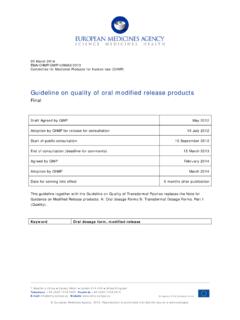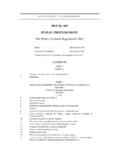Transcription of Q 1 A (R2) Stability Testing of new Drug Substances and ...
1 European Medicines Agency 7 Westferry Circus, Canary Wharf, London, E14 4HB, UK Tel. (44-20) 74 18 85 75 Fax (44-20) 75 23 70 40 E-mail: EMEA 2006 Reproduction and/or distribution of this document is authorised for non commercial purposes only provided the EMEA is acknowledged August 2003 CPMP/ICH/2736/99 ICH Topic Q 1 A (R2) Stability Testing of new Drug Substances and Products Step 5 NOTE FOR GUIDANCE ON Stability Testing : Stability Testing OF NEW DRUG Substances AND PRODUCTS (CPMP/ICH/2736/99) TRANSMISSION OF FIRST REVISION TO CPMP November 1999 RELEASE FOR CONSULTATION November 1999 DEADLINE FOR COMMENTS May 1999 APPROVAL OF FIRST REVISION BY CPMP November 2000 DATE FOR COMING INTO OPERATION June 2001 APPROVAL OF SECOND REVISION BY CPMP February 2003 DATE FOR COMING INTO OPERATION August 2003 EMEA 2006 2 INTRODUCTORY NOTE TO REVISION OF NOVEMBER 2000 The purpose of the Q1A revision is to add information to certain sections and to provide clarification to other sections of the guideline The most important sections that have been revised are: The section on stress Testing of the active substance has been moved from the glossary to the main text.
2 The texts on test procedures etc. have been brought in line with the Q6A guideline. Relevant cross-references to other ICH guidelines have been introduced. The text on Testing frequency has been amended for accelerated Testing conditions. Storage conditions have been described in more detail. Testing at low temperature and Testing of aqueous liquids in semi-permeable containers has been specifically addressed. The post-approval commitment is now described unambiguously The document has also been revised to remove several editorial inconsistencies, including some revision of the Glossary. INTRODUCTORY NOTE TO REVISION OF FEBRUARY 2003 The purpose of this note is to outline the changes made in Q1A(R) that result from adoption of ICH Q1F Stability Data Package for Registration Applications in Climatic Zones III and IV . These changes are: 1. The intermediate storage condition has been changed from 30 C 2 C/60% RH 5% RH to 30 C 2 C/65% RH 5% RH in the following sections: Drug Substance - Storage Conditions - General Case Drug Product - Storage Conditions - General Case Drug products packaged in semi-permeable containers 3 Glossary - Intermediate Testing 2.
3 30 C 2 C/65% RH 5% RH can be a suitable alternative long-term storage condition to 25 C 2 C/60% RH 5% in the following sections: Drug Substance - Storage Conditions - General Case Drug Product - Storage Conditions - General Case 3. 30 C 2 C/35% RH 5% RH has been added as a suitable alternative long-term storage condition to 25 C 2 C/40% RH 5% and the corresponding example for the ratio of water-loss rates has been included in the following section: Drug products packaged in semi-permeable containers Mid-stream switch of the intermediate storage condition from 30 C 2 C/60% RH 5% RH to 30 C 2 C/65% RH 5% RH can be appropriate provided that the respective storage conditions and the date of the switch are clearly documented and stated in the registration application. It is recommended that registration applications contain data from complete studies at the intermediate storage condition 30 C 2 C/65% RH 5% RH, if applicable, by three years after the date of publication of this revised guideline.
4 EMEA 2006 3 Stability Testing OF NEW DRUG Substances AND PRODUCTS TABLE OF CONTENTS 1. INTRODUCTION .. 4 Objectives of the Guideline .. 4 Scope of the Guideline .. 4 General principles 4 2. GUIDELINES .. 5 Drug Substance .. 5 General .. 5 Stress 5 Selection of Batches .. 5 Container Closure System .. 5 Specification .. 5 Testing Frequency .. 6 Storage Conditions .. 6 Stability 8 Evaluation .. 8 Statements/Labeling .. 9 Drug Product .. 9 General .. 9 Photostability Testing .. 9 Selection of Batches .. 9 Container Closure System .. 10 Specification .. 10 Testing Frequency .. 10 Storage Conditions .. 11 Stability 15 Evaluation .. 15 Statements/Labeling .. 16 3. GLOSSARY .. 16 4. REFERENCES .. 20 EMEA 2006 4 Stability Testing OF NEW DRUG Substances AND PRODUCTS 1.
5 INTRODUCTION Objectives of the Guideline The following guideline is a revised version of the ICH Q1A guideline and defines the Stability data package for a new drug substance or drug product that is sufficient for a registration application within the three regions of the EC, Japan, and the United States. It does not seek necessarily to cover the Testing for registration in or export to other areas of the world. The guideline seeks to exemplify the core Stability data package for new drug Substances and products, but leaves sufficient flexibility to encompass the variety of different practical situations that may be encountered due to specific scientific considerations and characteristics of the materials being evaluated. Alternative approaches can be used when there are scientifically justifiable reasons. Scope of the Guideline The guideline addresses the information to be submitted in registration applications for new molecular entities and associated drug products.
6 This guideline does not currently seek to cover the information to be submitted for abbreviated or abridged applications, variations, clinical trial applications, etc. Specific details of the sampling and Testing for particular dosage forms in their proposed container closures are not covered in this guideline. Further guidance on new dosage forms and on biotechnological/biological products can be found in ICH guidelines Q1C and Q5C, respectively. General principles The purpose of Stability Testing is to provide evidence on how the quality of a drug substance or drug product varies with time under the influence of a variety of environmental factors such as temperature, humidity, and light, and to establish a re-test period for the drug substance or a shelf life for the drug product and recommended storage conditions. The choice of test conditions defined in this guideline is based on an analysis of the effects of climatic conditions in the three regions of the EC, Japan and the United States.
7 The mean kinetic temperature in any part of the world can be derived from climatic data, and the world can be divided into four climatic zones, I-IV. This guideline addresses climatic zones I and II. The principle has been established that Stability information generated in any one of the three regions of the EC, Japan and the United States would be mutually acceptable to the other two regions, provided the information is consistent with this guideline and the labeling is in accord with national/regional requirements. EMEA 2006 5 2. GUIDELINES Drug Substance General Information on the Stability of the drug substance is an integral part of the systematic approach to Stability evaluation. Stress Testing Stress Testing of the drug substance can help identify the likely degradation products, which can in turn help establish the degradation pathways and the intrinsic Stability of the molecule and validate the Stability indicating power of the analytical procedures used.
8 The nature of the stress Testing will depend on the individual drug substance and the type of drug product involved. Stress Testing is likely to be carried out on a single batch of the drug substance. It should include the effect of temperatures (in 10 C increments ( , 50 C, 60 C, etc.) above that for accelerated Testing ), humidity ( , 75% RH or greater) where appropriate, oxidation, and photolysis on the drug substance. The Testing should also evaluate the susceptibility of the drug substance to hydrolysis across a wide range of pH values when in solution or suspension. Photostability Testing should be an integral part of stress Testing . The standard conditions for photostability Testing are described in ICH Q1B. Examining degradation products under stress conditions is useful in establishing degradation pathways and developing and validating suitable analytical procedures.
9 However, it may not be necessary to examine specifically for certain degradation products if it has been demonstrated that they are not formed under accelerated or long term storage conditions. Results from these studies will form an integral part of the information provided to regulatory authorities. Selection of Batches Data from formal Stability studies should be provided on at least three primary batches of the drug substance. The batches should be manufactured to a minimum of pilot scale by the same synthetic route as, and using a method of manufacture and procedure that simulates the final process to be used for, production batches. The overall quality of the batches of drug substance placed on formal Stability studies should be representative of the quality of the material to be made on a production scale. Other supporting data can be provided. Container Closure System The Stability studies should be conducted on the drug substance packaged in a container closure system that is the same as or simulates the packaging proposed for storage and distribution.
10 Specification Specification, which is a list of tests , reference to analytical procedures, and proposed acceptance criteria, is addressed in ICH Q6A and Q6B. In addition, specification for degradation products in a drug substance is discussed in Q3A. Stability studies should include Testing of those attributes of the drug substance that are susceptible to change during storage and are likely to influence quality, safety, and/or efficacy. The Testing should cover, as appropriate, the physical, chemical, biological, and EMEA 2006 6 microbiological attributes. Validated Stability -indicating analytical procedures should be applied. Whether and to what extent replication should be performed will depend on the results from validation studies. Testing Frequency For long-term studies, frequency of Testing should be sufficient to establish the Stability profile of the drug substance.













